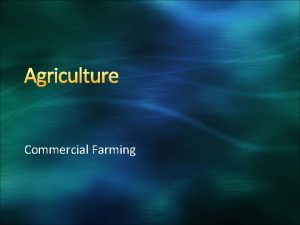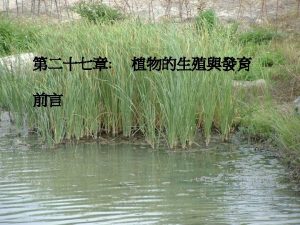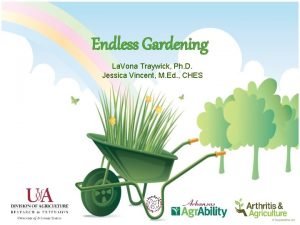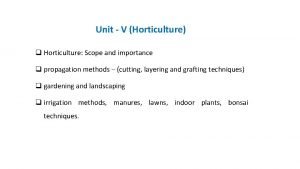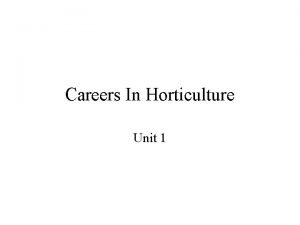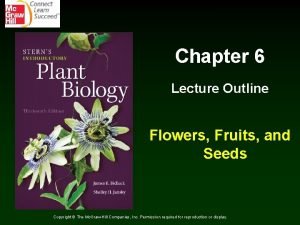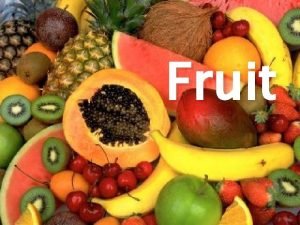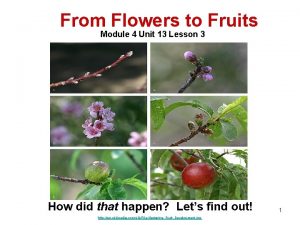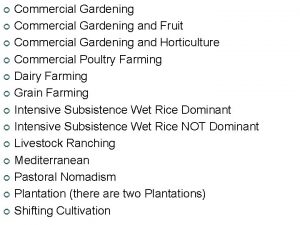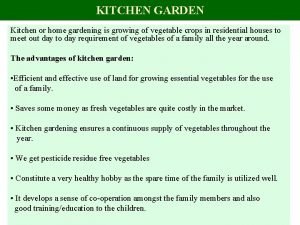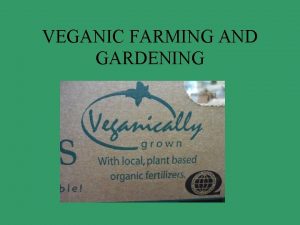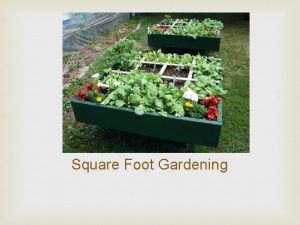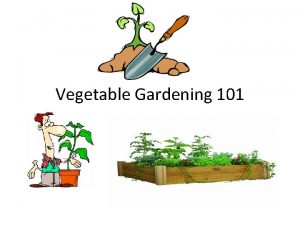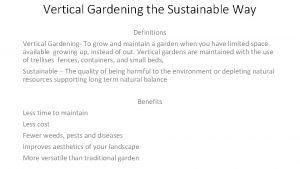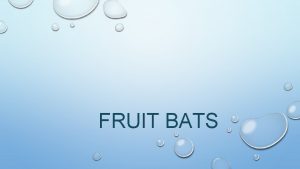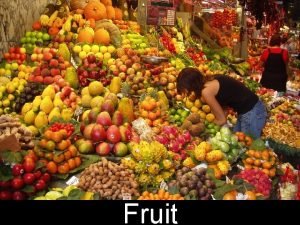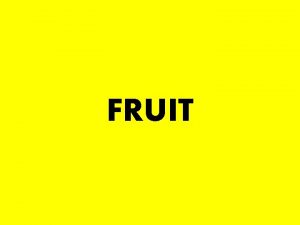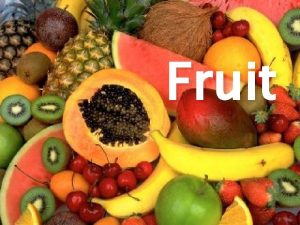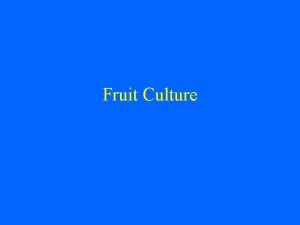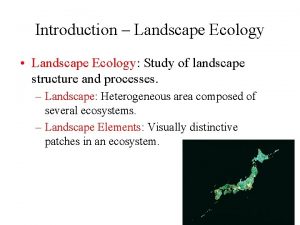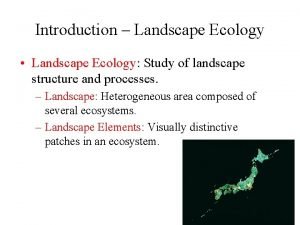Fruit Gardening Growing Fruit in the Garden Landscape





























































- Slides: 61

Fruit Gardening Growing Fruit in the Garden Landscape

Learning Objectives We will… • Describe the critical components of a suitable site for growing fruit and planning for minimizing pests. • Identify keys to success in a garden setting for: – Trees (apples, pears, peaches, cherry, plum) – Woody vines (grapes & kiwi) – Bushes/shrubs (elderberries, currants, gooseberries, blueberries) – Herbaceous perennials (raspberries & blackberries) – Ground cover (strawberries) – Become familiar with pruning strategies for fruit crops.

Discuss with a partner: Today’s pre-work was to research a particular fruit crop of interest using the Cornell Guide to Growing Fruit at Home. Pair up with a partner who chose the same fruit crop as you and discuss your findings. • What are some keys to success and best management practices? • What about site selection and pest prevention?

The most important years are the years before planting. Plan Prepare Produce

Key to Success: Consider your Site

Why won’t my plant set fruit? Has it produced fruit in the past? • If no: How old is the plant? • If yes: Did it produce flowers? – If no: what were the low winter temperatures? – If yes: Was there a late spring frost? Was there cold or rainy weather during bloom? What crop? (self-fruitful? ) • How is the plant cared for? Nutrition and management? • Are there any noticeable disease or pest issues? • Is the site too shady?

Key to Success: Start Small (A little can go a Long Way)

Key to success: Promote Soil Health Before Planting

Growing Trees (apples, pears, peaches, cherry, plum)

Choosing Cultivars (Cultivated Varieties) Right plant right place. Sansa Apple Consider cross pollination needs. Reference: CGGFH pg. 16

Apple Rootstock X

How big? Mature tree size depends on: • vigor of the rootstock • scion (cultivar grafted on rootstock) • characteristics of the soil • cultural practices M. 9 M. 26 M. 7 MM. 106 MM. 111 8 feet 24 feet

Rootstock for Other Tree Fruit Pears Old Home x Farmingdale Plums & Prunes St. Julian A Myrobalan Peaches Lovell Cherries Mahaleb Mazzard

Pruning and Training Start Early Encourage fruiting wood and horizontal branches

Pruning and Training Maximize Light Interception

Pruning Sharpen tools!

Tree Fruit Worksheet Fall Order 1 -2 -year-old plant stock Tie/stake Fall Tree Fruit Planting Year Winter Spring Plant & trim Mulch Apply starter solution Train Summer Tree Fruit Years After Planting Winter Spring Summer Prune and train in February Consider fertilizing in April Mulch -March Prune Peaches Pinch & Train Thin fruit in June Insect and disease management throughout.

More Edible Fruit Trees… • • Amelanchier (juneberry, serviceberry, shadbush…) Dogwood trees (Cornelian cherry…) Mulberry Pawpaw Beach plums Buffaloberry Quince Persimmons References: • North American Fruit Explorers http: //www. nafex. org/ • CGGFH pg. 95

Growing Vines (grapes, hardy kiwi)

Grape Types • Vitis labrusca (Fox grape) • French-American hybrids • Vitis vinifera (traditional European species) • Vitis rotundifolia (Muscadine)

Relative Disease Susceptibility Black rot Downy mildew Powdery mildew Botrytis Catawba +++ ++ + Concord +++ + Delaware ++ ++ + Niagara +++ ++ + Aurora +++ ++ +++ Cayuga + ++ + + Chancellor + +++ + Foch ++ + Seyval ++ ++ +++ Chardonnay +++ +++ Riesling +++ +++ The more + = more susceptible Reference: CGGFH pg 43

Fungal Diseases Black Rot Powdery Mildew Downy Mildew Botrytis Reference: CGGFH pg. 49

Pruning and Training Don’t let vines become overgrown. Removal up to 90% of the new growth. Buds on one-year-old wood bear fruit.

Four-arm Kniffin System Reference: CGGFH pg. 47

Put These Actions in your Grape Worksheet Fall Prepare soil and install trellis Grape Planting Year Winter Purchase or propagate grapevine Spring Summer Early Late Let grow Plant grape When new vines and shoots are one Tie/stake remove to inch or less, one cane remove all but Mulch the strongest shoots Insect and disease management throughout.

Put These Actions in your Grape Worksheet Harvest Fall Grape Years After Planting Winter Prune in February-March Spring Fertilize in April Protect tender cultivars Insect and disease management throughout. Summer Remove any flower clusters the first 2 years and possibly 3 years, depending on cane growth

Hardy Kiwi: Keys to Success Oregon State University Extension Fruit Production Guide Reference: CGGFH pg. 92

Growing Bushes/Canes (elderberries, ribes, blueberries, raspberries and blackberries)

Elderberries Reference: CGGFH pg. 90

Ribes (currants, gooseberries) Reference: CGGFH pg. 84

Choosing Cultivars Fungal Disease – White Pine Blister Rust • Avoid susceptible black currants.

Choosing the Place • Good air circulation • Cool, moist, partial shade OK • Prefer rich soil • Heavy nitrogen feeders

Pruning Always remove diseased and broken shoots Year 1 keep 6 to 8 vigorous shoots Year 2 keep 4 to 5 one year old, and 3 to 4 two year old shoots Year 3 keep 3 to 4 shoots in each age class Year 4 remove oldest shoots and do as in Year 3 with others

Ribes Worksheet Early Fall Purchase plants Ribes (currants and gooseberries) Planting Year Fall Add manure to planting hole Early Spring Remove flowers Mulch Early Fall Weed Ribes Years After Planting Fall Replenish mulch in fall or early spring Summer Early Spring Prune and trellis Fertilize Replenish mulch in fall and early spring Adequate water Insect and disease management throughout. Weed Harvest Summer Adequate water

Blueberries rabiteye blueberry Vaccinium ashei lowbush blueberry Vaccinium angustifolium half-high blueberry high-bush blueberry Vaccinium corymbosum northern southern Reference: CGGFH pg. 77

Choose Cultivars Right plant, right place. Consider cross pollination benefits.

Pruning Prune in early spring Do not “hedge” prune. Remove from point of origin Always remove diseased and broken Remove old, large canes > 1 inch diameter Keep about 2 new canes per year up to 8 years Remove up to 20% of neglected bushes

Fungal Diseases Fusicoccum canker Phomopsis canker *Some twig redness is normal cane aging. Reference: CGGFH pg. 82

Blueberry Worksheet Blueberries Planting Year Winter Early Spring Purchase 2 -3 year old plants Plant Prune to balance shoot to root Weed Mulch Adequate Water Insect and disease management Summer Remove flowers Weed Mulch Adequate Water Insect and disease management Fall

Blueberry Worksheet Winter Blueberries Years After Planting Prune Early Spring Harvest Summer Weed Fall Fertilize Weed Mulch Adequate Water Insect and disease management

Brambles Idaeobatus (Raspberries) R. occidentalis R. idaeus black red and yellow Eubatus (Blackberries) • erect • semi-trailing • trailing R. neglectus purple Raspberry-Blackberry hybrids (such as Loganberry) Reference: CGGFH pg. 65

Fungal Diseases Verticillium wilt Phytophthora root rot Reference: CGGFH pg. 73

Raspberry Types Primocane (fall) fruiting • Fall or everbearing • Red or yellow Floricane (summer) fruiting • Summer bearing • Red, yellow, black or purple

Primocane Fruiting Brambles Worksheet Winter Purchase plants Primocane (fall) Fruiting Brambles Planting Year and Beyond Early Plant Spring Late Fertilize Weed Mulch Summer Trellis Weed Mulch Harvest Adequate water Weed Adequate water Insect and disease management throughout. Fall Cut to ground Mulch Adequate water

Trellising Primocane Fruiting Plants Keeps berries off ground Makes harvest easier Reference: CGGFH pg. 70

Floricane Fruiting Brambles Worksheet Winter Purchase plants Floricane (summer) Fruiting Brambles Planting Year Early Plant Spring Late Fertilize Weed Summer Tip black and purple Weed Adequate water, avoid prolonged wet leaves Insect and disease management throughout. Trellis Fall Weed Adequate water, avoid prolonged wet leaves

Floricane Fruiting Brambles Worksheet Winter Floricane Fruiting Brambles Years After Planting Early Spring Prune and trellis Harvest Fertilize Remove spent floricanes Weed Mulch Adequate water Insect and disease management throughout. Summer Fall Tie canes to trellis

Trellising Floricane Fruiting Plants Reduces winter breakage. Keeps berries off ground. Makes harvest easier. Can reduce interference among canes. Reference: CGGFH pg. 71

Pruning Floricane fruiting BLACK and PURPLE 2 to 3 canes per hill Floricane fruiting RED 3 to 4 canes per foot of row

More bushes & shrubs • Aronia/Chokeberry • Beach plums • Rubus species North American Fruit Explorers www. nafex. org/ Reference: CGGFH pg. 95

Growing Groundcover (strawberries) Fragaria x ananassa Duch. • June-bearing • Day-neutral • Everbearing Reference: CGGFH pg. 54

Planting Reference: CGGFH pg. 57

Strawberry Worksheet Winter Purchase plants Strawberry Planting Year Early Plant Weed Early Spring Late Fertilize Weed Remove flowers Remove as desired flowers as desired Adequate water Water Insect and disease manage Insect and -ment disease management Summer Weed Remove flowers as desired Adequate water Insect and disease management Fertilize Fall Straw mulch Weed Remove flowers as desired Adequate water Insect and disease management

Strawberry Worksheet Winter Strawberries Years After Planting Early Spring Remove mulch (Row cover until bloom) Frost protection Adequate water Insect and disease management Harvest Summer Renovation: Mow, weed, narrow rows, fertilize Adequate water Insect and disease management Fall Straw mulch Fertilize Insect and disease management

Ounce of Prevention • • Evaluate site conditions and options Plant resistant cultivars Start with healthy plants Supply adequate: space, water & nutrients Commit to proper pruning & training Cleaned up crop debris Provide habitat for beneficials Know pests’ life cycles

Cornell Guidelines for Commercial Tree Fruit Production (CGCTFP)


Small Group Discussions Get into small groups and discuss what you have just learned about fruit crops. – What questions do you still have? Where might they be answered? – What surprised you? – Where will your next fruit growing experience be? – How will you reach beyond your garden gate to share this knowledge with others?

Learning Objectives Today we: • Described the critical components of a suitable site for growing fruit and planning for minimizing pests. • Identified keys to success in a garden setting for: – Trees (apples, pears, peaches, cherry, plum) – Woody vines (grapes & kiwi) – Bushes/shrubs (elderberries, currants, gooseberries, blueberries) – Herbaceous perennials (strawberries and caneberries such as raspberries & blackberries) – Became familiar with pruning strategies for fruit crops.

References: – Cornell Guide to Growing Fruit at Home – Growing Fruit in the Garden Landscape presentation, created by Lori Brewer and revised by Laura Mc. Dermott (2013)

Learn More Contact: Cornell Garden-Based Learning https: //nysipm. cornell. edu/agriculture/fruits/cceprograms/statewide/ Published: April 2019 Author: Lori Brewer, Senior Extension Associate Revised: Laura Mc. Dermott, Regional Extension Specialist, Eastern NY Commercial Horticulture Program Reviewer: Fiona Doherty, Extension Support Specialist I, Russell Welser, Senior Resource Educator, Gregory Peck, Assistant Professor
 Commercial farming define
Commercial farming define Megaspore 2n
Megaspore 2n Gardening with arthritis
Gardening with arthritis Truck farming definition ap human geography
Truck farming definition ap human geography Ohio state extension gardening
Ohio state extension gardening Market gardening definition ap human geography
Market gardening definition ap human geography Paddy madden gardening
Paddy madden gardening Az1435
Az1435 Dewey decimal gardening
Dewey decimal gardening Objectives of gardening
Objectives of gardening Gulf coast vegetable gardening
Gulf coast vegetable gardening Intertillage ap human geography
Intertillage ap human geography Gardening soil mix
Gardening soil mix Importance of horticulture
Importance of horticulture Paddy madden school garden
Paddy madden school garden Lecture about flowers
Lecture about flowers Fruit vegetable definition
Fruit vegetable definition Aggregate fruit develops from
Aggregate fruit develops from Thể thơ truyền thống
Thể thơ truyền thống Bài hát chúa yêu trần thế alleluia
Bài hát chúa yêu trần thế alleluia Khi nào hổ con có thể sống độc lập
Khi nào hổ con có thể sống độc lập Diễn thế sinh thái là
Diễn thế sinh thái là Vẽ hình chiếu vuông góc của vật thể sau
Vẽ hình chiếu vuông góc của vật thể sau Công thức tính độ biến thiên đông lượng
Công thức tính độ biến thiên đông lượng Phép trừ bù
Phép trừ bù Tỉ lệ cơ thể trẻ em
Tỉ lệ cơ thể trẻ em Thế nào là mạng điện lắp đặt kiểu nổi
Thế nào là mạng điện lắp đặt kiểu nổi Lời thề hippocrates
Lời thề hippocrates đại từ thay thế
đại từ thay thế Vẽ hình chiếu đứng bằng cạnh của vật thể
Vẽ hình chiếu đứng bằng cạnh của vật thể Quá trình desamine hóa có thể tạo ra
Quá trình desamine hóa có thể tạo ra Các môn thể thao bắt đầu bằng tiếng chạy
Các môn thể thao bắt đầu bằng tiếng chạy Hình ảnh bộ gõ cơ thể búng tay
Hình ảnh bộ gõ cơ thể búng tay Khi nào hổ mẹ dạy hổ con săn mồi
Khi nào hổ mẹ dạy hổ con săn mồi Dot
Dot Nguyên nhân của sự mỏi cơ sinh 8
Nguyên nhân của sự mỏi cơ sinh 8 Trời xanh đây là của chúng ta thể thơ
Trời xanh đây là của chúng ta thể thơ độ dài liên kết
độ dài liên kết Chó sói
Chó sói Thiếu nhi thế giới liên hoan
Thiếu nhi thế giới liên hoan Fecboak
Fecboak điện thế nghỉ
điện thế nghỉ Một số thể thơ truyền thống
Một số thể thơ truyền thống Thế nào là hệ số cao nhất
Thế nào là hệ số cao nhất Hệ hô hấp
Hệ hô hấp Ng-html
Ng-html Thế nào là số nguyên tố
Thế nào là số nguyên tố đặc điểm cơ thể của người tối cổ
đặc điểm cơ thể của người tối cổ Các châu lục và đại dương trên thế giới
Các châu lục và đại dương trên thế giới Tư thế worm breton
Tư thế worm breton ưu thế lai là gì
ưu thế lai là gì Thẻ vin
Thẻ vin Tư thế ngồi viết
Tư thế ngồi viết Bàn tay mà dây bẩn
Bàn tay mà dây bẩn Cách giải mật thư tọa độ
Cách giải mật thư tọa độ Các châu lục và đại dương trên thế giới
Các châu lục và đại dương trên thế giới Từ ngữ thể hiện lòng nhân hậu
Từ ngữ thể hiện lòng nhân hậu Bổ thể
Bổ thể Tư thế ngồi viết
Tư thế ngồi viết Ví dụ giọng cùng tên
Ví dụ giọng cùng tên My inner landscape essay 400 words
My inner landscape essay 400 words Perkins geology museum
Perkins geology museum
